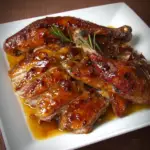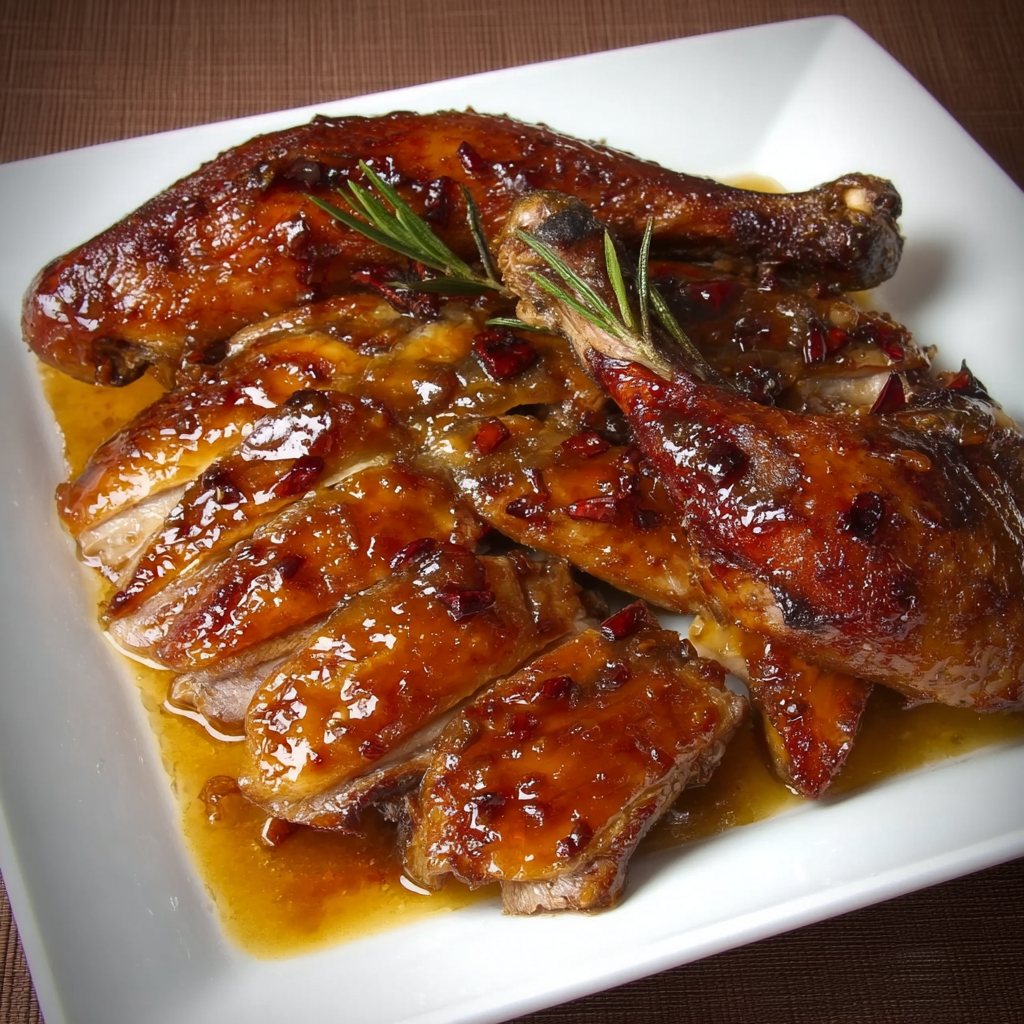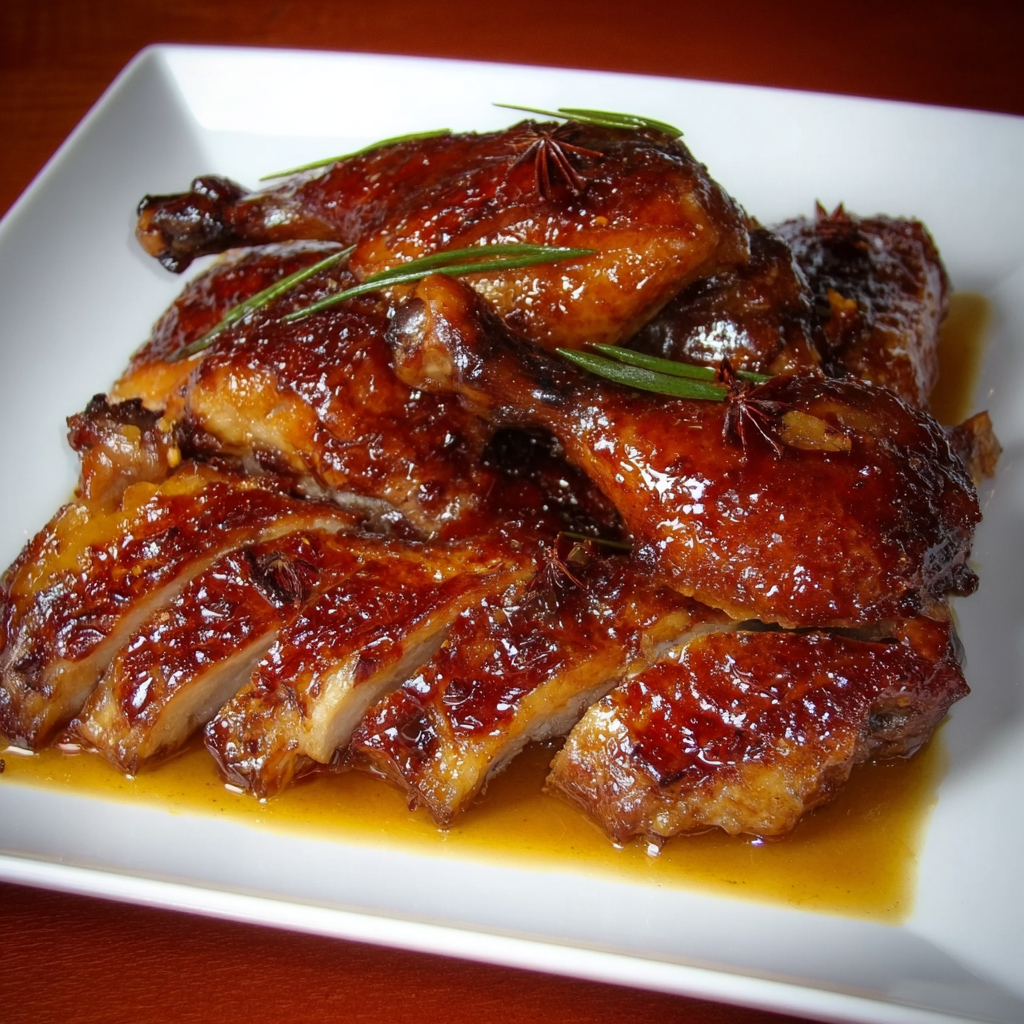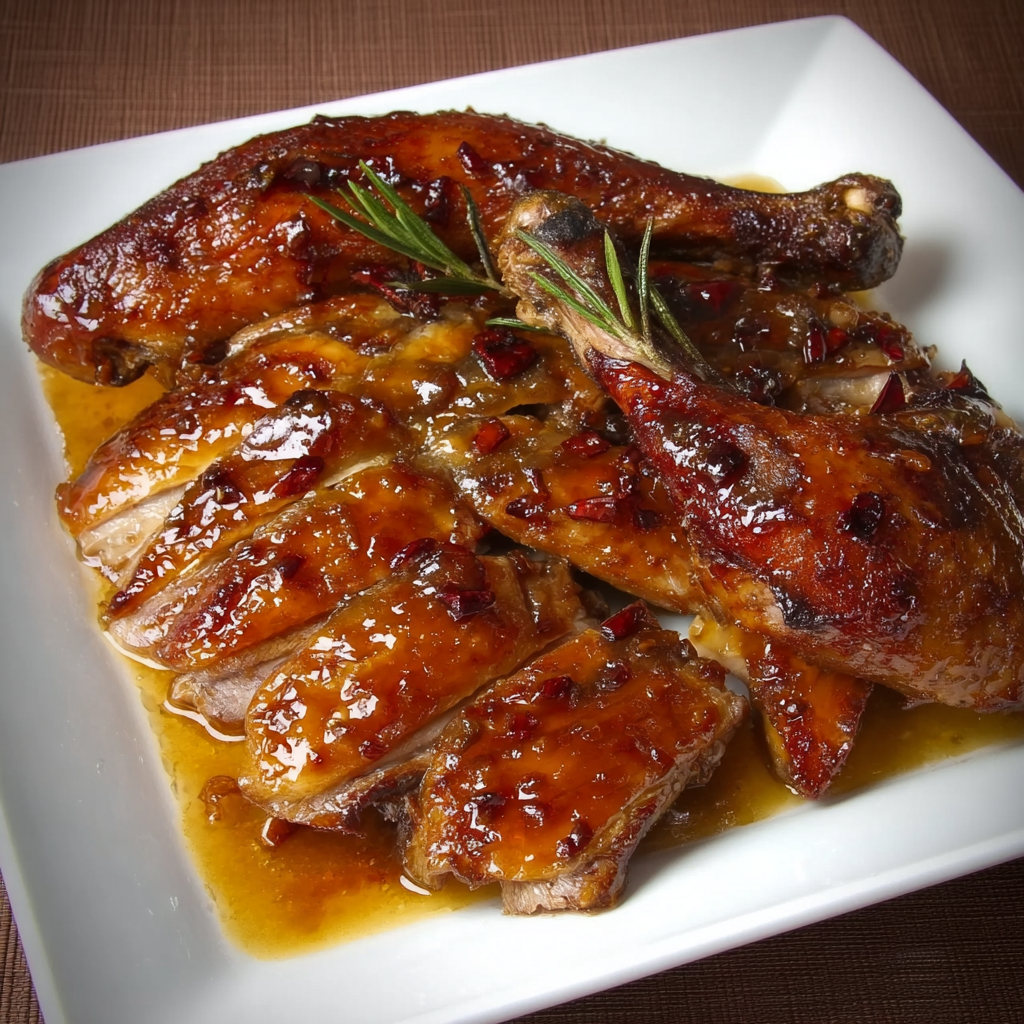1. Introduction to the Recipe
Roast duck has long been considered a luxury dish, but with this easy plum and ginger roasted duck recipe, you can bring gourmet flavors right into your home kitchen with surprisingly little effort. The combination of sweet plums, fragrant ginger, and warming spices creates a deeply flavorful glaze that turns a simple five-pound duck into an aromatic, show-stopping centerpiece. While duck can be intimidating for some home cooks, this recipe simplifies the process with straightforward steps and accessible ingredients, ensuring anyone can achieve perfectly crispy skin and tender, juicy meat.
This recipe showcases how fruit-based sauces—especially plum—beautifully balance the richness of duck. For more insights into pairing fruit with savory meats, check out guides like this fruit sauce overview: https://www.seriouseats.com/savory-fruit-sauces. Additionally, if you’re new to cooking whole duck, a roasting guide like this one provides helpful background on timing and temperature: https://www.themom100.com/guide/how-to-roast-duck/. These supplemental resources can give you added confidence as you master this impressive recipe.
What makes this dish stand out is its rich, aromatic profile. Plum jam creates a glossy, sticky glaze that caramelizes beautifully in the oven. Ground ginger adds warmth, coriander lends a whisper of citrus fragrance, and sea salt ties everything together with balanced savoriness. The sauce—made with canned plums, honey, star anise, and syrup—enhances the duck even further, creating a complex blend of tangy, sweet, and gently spiced flavors. Whether you’re planning a holiday dinner, entertaining guests, or simply treating yourself to a special meal, this recipe delivers elegance without complication.
Duck is naturally rich and flavorful, so the glaze and sauce complement rather than overwhelm it. Each bite offers crispy skin, succulent meat, and a bright, fruity finish. In this full-length article, you’ll discover not only the recipe itself but also professional cooking techniques, storage and reheating methods, dietary adaptations, frequently asked questions, and thoughtful final insights. This is more than just a recipe—it’s a complete guide to mastering easy plum and ginger roasted duck with confidence and creativity.
2. Basic Recipe: Ingredients and Instructions
Print
Easy Plum and Ginger Roasted Duck Recipe
Description
This easy plum and ginger roasted duck recipe delivers crispy skin, tender meat, and a sweet-savory plum sauce.
Ingredients
For the Duck
- 1 duck, 5 lb / 2.2 kg
For the Glaze
- 1 cup plum jam
- 2 tsp ground coriander
- 1 tsp ground ginger
- 2 tsp sea salt
For the Sauce
- 2 tbsp honey
- 1 star anise
- 1 tsp ground ginger
- 28 oz canned plums (800 g), pitted and halved, syrup reserved
Instructions
- Prep the duck: Pat the duck dry inside and out. Trim excess fat and score skin lightly in a diamond pattern without piercing the meat.
- Prepare the glaze: Mix plum jam, ground coriander, ginger, and sea salt in a bowl until smooth.
- Glaze the duck: Rub half of the glaze over the duck, making sure to work it into the scored skin.
- Begin roasting: Place duck on a rack in a roasting pan. Roast at 350°F (180°C) for 1 hour.
- Render fat and reglaze: Carefully remove fat from the pan. Brush the remaining glaze over the duck.
- Finish roasting: Continue roasting another 45–60 minutes until skin is crisp and internal temperature reaches 165°F (74°C).
- Make the sauce: Combine plums, syrup, honey, ginger, and star anise in a saucepan. Simmer 10–15 minutes until thickened.
- Serve: Let the duck rest 10 minutes, carve, and serve with the plum ginger sauce.
Notes
Duck produces a lot of fat; save it for roasting potatoes.
Scoring the skin helps render fat and crisp the skin.
Canned plums create a smooth, rich sauce that pairs perfectly with roasted duck.
3. Advanced Techniques
Mastering Perfectly Rendered Duck Skin
Achieving crispy skin is essential for easy plum and ginger roasted duck, and the key lies in properly rendering the fat. Duck skin is much thicker than chicken or turkey, so scoring the skin in shallow diagonal lines allows fat to escape during roasting. Starting the duck at a moderate temperature helps the fat render slowly without burning the exterior. Removing excess fat from the pan halfway through prevents steaming and encourages crisping. If the skin needs extra texture, finish under a broiler for 1–2 minutes—just watch carefully to avoid scorching the glaze.
Building Layered Flavor with a Multi-Stage Glazing Technique
Applying glaze only once limits caramelization, but glazing in two or even three stages builds glossy, complex flavor. The first glaze layer infuses the skin with spices as the fat renders. A second coating deepens the color and adds sweetness that caramelizes beautifully. For a third layer, apply a thin glazing during the last 10 minutes of roasting to create a lacquered finish. Each stage reinforces the combination of plum, ginger, and coriander, ensuring a beautifully balanced sweet-savory crust.
Enhancing the Plum Sauce with Spice Infusion
The simple plum sauce becomes extraordinary when infused properly. Simmering star anise with honey and ginger intensifies the aromatics and extracts deeper flavor from the plums. If you want even more sophistication, add a cinnamon stick, a splash of balsamic vinegar, or a small piece of fresh ginger. Allow the sauce to simmer until glossy and thickened; this technique concentrates sweetness and elevates the natural fruitiness of the canned plums. Straining the sauce yields a silky, restaurant-style texture.
Carving the Duck for Maximum Tenderness
Carving duck differs from carving chicken because duck breast is best sliced against the grain. After resting, remove the legs first by cutting through the joint. Next, lift the breasts off the bone with a long slicing motion. Slice each breast into thin pieces for maximum tenderness and an attractive presentation. Removing the wings last prevents tearing the skin. Carving properly ensures each portion contains both crispy skin and juicy meat, enhancing the overall experience.
Using Residual Heat to Preserve Juiciness
Duck can dry out if cooked aggressively, so understanding residual heat is beneficial. When the duck reaches 160°F (71°C), remove it from the oven and let it rest. The temperature will rise naturally to 165°F (74°C) without overcooking. Resting allows juices to redistribute, ensuring the meat stays moist. Tent the duck loosely with foil to retain warmth without trapping steam, which could soften the skin. This small technique makes a big difference in final texture.

4. Storage, Shelf Life, and Maintenance Tips
Refrigerating Leftover Duck Properly
Store leftover duck in shallow airtight containers, separating meat, skin, and sauce if possible. Duck keeps well in the refrigerator for 3–4 days. To maintain crispness, keep the skin uncovered on a small plate so it stays dry. Refrigerating the sauce separately prevents sogginess and keeps the flavors bright. When reheating, add a splash of water or broth to maintain tenderness.
Freezing Cooked Duck for Long-Term Storage
Roasted duck freezes remarkably well. Cool completely before wrapping individual portions in parchment and storing them in freezer-safe bags. Frozen duck maintains quality for up to 3 months. Freeze the plum sauce separately in small containers. Thaw overnight in the fridge. Reheat gently in the oven to avoid drying. The glaze and sauce retain their flavor beautifully, making this a great make-ahead holiday dish.
Maintaining Skin Crispness After Storage
The biggest challenge with storing duck is preserving the crispy skin. To restore texture, place duck pieces skin-side-up on a wire rack and reheat at 375°F (190°C) for 8–10 minutes. Avoid microwaving, as it makes the skin rubbery. If needed, broil for 1–2 minutes at the end. Keeping the skin separate during storage ensures the best results.
Reheating Duck Meat Without Drying It Out
Duck is richer than chicken but still vulnerable to overcooking when reheated. Warm gently at 300°F (150°C) with a spoonful of broth or reserved plum sauce. Cover lightly with foil to prevent direct heat exposure. If reheating in a skillet, use low heat and add a splash of water to create gentle steam. This slow method keeps the meat tender and flavorful.
Storing Plum Sauce to Maintain Freshness
Plum sauce keeps for 5–6 days in an airtight jar and tastes even better on day two, as the flavors meld. For longer storage, freeze in small portions. Reheat slowly on the stovetop and add a drizzle of honey if the sauce thickens too much. The spices become more pronounced over time, making leftovers exceptionally flavorful.

5. Dietary Adaptations and Substitutions
Gluten-Free Adaptation
This recipe is naturally gluten-free, but it’s still important to check labels on plum jam and canned plums to ensure they contain no wheat-based thickeners. If adding optional spices or vinegars to the sauce, verify their gluten-free status as well. Everything else—from duck to honey to ginger—is naturally safe. This makes easy plum and ginger roasted duck an excellent choice for guests with gluten sensitivities.
Low-Sodium Adaptation
To reduce sodium, use unsalted plum jam and omit or reduce the sea salt in the glaze. Duck’s natural richness enhances flavor even without added salt, and spices like ginger, star anise, and coriander offer aromatic complexity. Consider adding citrus zest or a splash of rice vinegar to brighten the flavor without increasing sodium. Canned plums should be drained and rinsed if the syrup is high in sodium.
Low-Sugar or No-Sugar Version
Duck pairs beautifully with fruit flavors, but if you need to reduce sugar, replace plum jam with no-sugar-added plum preserves or use blended fresh plums. Reduce honey in the sauce and adjust sweetness with cinnamon or vanilla instead. The natural richness of the duck ensures the dish still tastes balanced, even with less sugar. A dash of balsamic vinegar provides depth without sweetness.
Dairy-Free Adaptation
This recipe is naturally dairy-free, making it simple to adapt for anyone avoiding dairy. The glaze uses jam and spices, and the sauce relies on honey and fruit rather than butter or cream. If you wish to baste the duck more frequently, use duck fat or a neutral oil instead of butter. The flavor remains fully intact, and the dish stays allergy-friendly.
Alcohol-Free Adaptation
The recipe contains no alcohol, but if you choose to enhance the sauce with wine or liqueur, it’s easy to substitute. Replace any alcohol with extra plum syrup or a splash of apple juice. Add star anise or cinnamon to deepen the flavor profile without adding alcohol’s boldness. This keeps the dish accessible for all ages and dietary restrictions.

6. FAQs About the Recipe
How Do I Know When the Duck Is Fully Cooked?
Duck should reach an internal temperature of 165°F (74°C) in the thickest part of the thigh. A meat thermometer ensures accuracy. If you prefer slightly pink breast meat, remove the duck earlier and allow residual heat to finish the cooking process. Clear juices and easily movable leg joints are good signs of doneness. Overcooking can dry out the meat, so temperature monitoring is essential.
Why Isn’t My Duck Skin Crispy?
Crispiness depends on proper fat rendering. If the skin isn’t crisping, the duck may need more time at a moderate temperature. Make sure the skin is thoroughly dried before glazing. Removing accumulated pan fat halfway through prevents steaming. Scoring the skin helps fat escape, and finishing under a broiler provides the final touch of crispness.
Can I Use Fresh Plums Instead of Canned?
Yes—fresh plums work beautifully. Choose firm, ripe fruit and cook them with honey, ginger, and a splash of water or broth. Fresh plums yield a slightly brighter, more tart flavor, while canned plums offer richness and a ready-made syrup that enhances the sauce. Both versions pair wonderfully with roasted duck.
Can I Prepare This Recipe Ahead of Time?
Absolutely. You can prepare the glaze up to three days ahead and store it in the fridge. The sauce also reheats well and can be made a day in advance. While roasting the duck itself is best done fresh, you can partially roast it, cool it, and finish the final 30 minutes before serving. This makes holiday cooking much more manageable.
What Should I Serve with Plum and Ginger Roasted Duck?
This duck pairs perfectly with roasted potatoes, jasmine rice, sautéed greens, or polenta. The sweet-savory plum sauce also works beautifully with earthy vegetables like carrots, parsnips, or cabbage. A simple green salad with citrus or vinegar dressing cuts through the richness of the duck and balances the meal.

7. Conclusion & Final Thoughts
This easy plum and ginger roasted duck recipe transforms a traditional and often intimidating dish into something accessible, flavorful, and truly special. The combination of crispy golden skin, succulent meat, and fragrant plum-ginger glaze results in a meal that feels both festive and deeply comforting. Whether you’re preparing it for a holiday gathering or a quiet weekend dinner, it brings a sense of celebration to the table with minimal stress.
The beauty of this dish lies in its thoughtful simplicity. Each component—from the spice-filled glaze to the aromatic plum sauce—works together to enhance the natural richness of the duck without overwhelming it. The recipe is flexible enough to suit different palates and dietary needs, and once you understand the techniques behind rendering the fat and glazing the skin, it becomes an enjoyable and reliable recipe you can make again and again.
Beyond the wonderful flavors, this dish also offers an opportunity to slow down and savor the cooking process. Roasting a whole duck invites a sense of ceremony, and the aromas of ginger, coriander, honey, and warm plum are every bit as satisfying as the final taste. It’s a recipe that brings people together, turning even an ordinary evening into something memorable. With its balanced sweetness, gentle spice, and luscious sauce, easy plum and ginger roasted duck is sure to become a cherished favorite in your kitchen—rich, beautiful, and irresistibly delicious.
